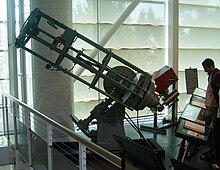Henri Chrétien
Henri Chrétien (born February 1, 1879 in Paris , † February 6, 1956 in Washington ) was a French astronomer , professor and inventor .
Life
The beginning of his professional career was at the Observatoire de Nice . Part of this observatory - the "Pavillon Henri Chretien" (PHC) - is named after him today. He lived in the "Villa Paradou" property built by Charles Garnier , the architect of the Paris Opera , below the observatory on Mont Gros. His friend Gustave Eiffel designed a dome-like pavilion for the spacious park. The street leading to the property via Nice was renamed "Avenue Professeur Henri Chrétien" after his death. In his will, he determined the American Astronomical Society (AAS) to inherit the property with a main villa and another guest villa. Although the property was named a Monument historique due to its location and its prominent builder and was of great value due to its location, it was not used by the AAS and was neglected, although several efforts were made by the city or by local associations to clear the site to expand a monument to Henri Chrétien and an astronomical museum.
Inventions
Henri Chrétien is the inventor of the hypergonar lens, also known as anamorphic lens, which makes it possible to distort a wide image so that it fits into a standard frame during filming and later creates a wide image again when projected. Chrétien invented this invention as early as 1927. In the following year, the filmmaker Claude Autant-Lara used the new lens to shoot his short film “Construire un Feu”. After this film, the anamorphoscope was forgotten. It wasn't until after 25 years that Chrétien's patents had expired that American studios suddenly became interested in his optics.
The film industry only recognized the need to produce films in larger or wider versions and thus stand out from television when the rapidly spreading television attracted more and more cinema viewers to the couches at home. In 1953 the wide screen Cinemascope method was introduced in the USA . The US film company 20th Century Fox secured world rights from Chrétien (with the exception of France) and produced " The Robe " with Richard Burton in the leading role and cameraman Leon Shamroy, the first wide-screen film to be shot using the so-called "Cinemascope" technique. The aspect ratio was 1: 2.55 with 4-channel magnetic sound (3 channels behind the screen and a so-called audience channel), a forerunner of surround sound.
The anamorphoscopic lens was subsequently used in Panavision and other wide screen formats. In 1954, Chrétien subsequently received an Oscar for his contribution to the development of the Cinemascope process.
Together with George Willis Ritchey , he also developed the Ritchey-Chrétien telescope . Well-known Ritchey-Chrétien telescopes are the Hubble Space Telescope and the Very Large Telescope , which is part of the Paranal Observatory .
Awards
- 1901 Jules Janssen Prize
- An astronomy award bears his name, the "Chrétien International Research Grants".
- In 1954 he subsequently received an Oscar for his work on the development of the Cinemascope process.
- A lunar crater was named after Chrétien in 1970 , the 99 km Chrétien crater .
- In 2016 an asteroid was named after Chrétien: (341958) Chrétien .
- He received the Legion of Honor Cross from the French government for his achievements in ballistics and aerodynamics during the First World War . In 1949 he was appointed officer of the Legion of Honor.
Individual evidence
- ↑ Chrétien International Research Grants ( Memento of the original of February 14, 2009 in the Internet Archive ) Info: The archive link was automatically inserted and has not yet been checked. Please check the original and archive link according to the instructions and then remove this notice.
Web links
- Publications by H. Chrétien in the Astrophysics Data System
- SR: Henri Chrétien (1879-1956). L'Astronomie, Vol. 71 (1957), p. 257 (obituary, French)
- BIOGRAPHICAL NOTE: Henri Chrétien and his Magnificent Contribution to the design of Telescopes (English)
| personal data | |
|---|---|
| SURNAME | Chrétien, Henri |
| BRIEF DESCRIPTION | French astronomer and inventor |
| DATE OF BIRTH | February 1, 1879 |
| PLACE OF BIRTH | Paris |
| DATE OF DEATH | February 6, 1956 |
| Place of death | Washington, DC |

